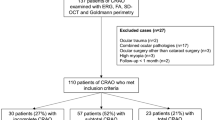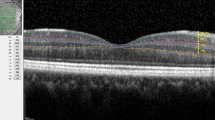Abstract
Background
We investigated the relationship between the retinal thickness and electroretinogram (ERG) components in patients with central retinal artery occlusion (CRAO).
Methods
The optical coherence tomographic (OCT) images and ERGs of the nine patients (six men and three women; mean age, 61.8 years) were retrospectively analyzed. The thickness of the inner and outer retinal layers at 1 and 2 mm nasal and temporal to the fovea was measured in the horizontally scanned OCT images. The ratio of the inner layer thickness/sensory retinal thickness (IT/ST ratio) was calculated. The amplitudes of the a- and b-waves of the mixed rod-cone ERGs and the photopic negative response (PhNR) of the photopic ERGs were analyzed. The ratio of the amplitude of each component in the affected eye to that of the healthy fellow eye (a/f ratio) was calculated.
Results
In the chronic phase (1 to 8 months after onset, eight eyes), the inner layer was significantly thinner than that in the acute phase (P = 0.0147, 0.0076, 0.002, and 0.0003 for 2 mm nasal, 1 mm nasal, 1 mm temporal, and 2 mm temporal respectively, within 5 days of onset, six eyes), while the thickness of outer layer was not significantly changed. The ERGs were recorded 6.4 ± 1.5 days after the onset of CRAO. The median of the a/f ratio was 0.84 in the a-wave, 0.56 in the b-wave, and 0.27 in the PhNR. The IT/ST in the chronic phase was positively correlated with the a/f ratio of the amplitude of the PhNR.
Conclusions
Measurement of retinal thickness by OCT can be useful for monitoring the changes following CRAO. The correlation between the retinal thickness, especially inner layer thickness, and the ERG components was determined, suggesting that the PhNR in the acute phase might be a good indicator for predicting the thinning of the damaged retina in the chronic phase.






Similar content being viewed by others
References
Henkes HE (1954) Electroretinography in circulatory disturbances of the retina: Electroretinogram in cases of occlusion of the central retinal artery or one of its branches. Arch Ophthalmol 51:42–53
Carr R, Siegel I (1964) Electrophysiologic aspects of several retinal diseases. Am J Ophthalmol 58:95–107
Hamasaki DI, Kroll AJ (1968) Experimental central retinal artery occlusion. An electrophysiological study. Arch Ophthalmol 80:243–248
Miyake Y (2006) Central reinal artery occlusion. In: Miyake Y (ed) Electrodiagnosis of Retinal Diseases. Springer-Verlag, Tokyo, pp 181–182
Siliprandi R, Canella R, Carmignoto G, Schiavo N, Zanellato A, Zanoni R, Vantini G (1992) N-methyl-Daspartate-induced neurotoxicity in the adult rat retina. Vis Neurosci 8:567–563
Machida S, Gotoh Y, Tanaka M, Tazawa Y (2004) Predominant loss of the photopic negative response in central retinal artery occlusion. Am J Ophthalmol 137:938–940
Viswanathan S, Frishman LJ, Robson JG, Harwerth RS, Smith EL 3rd (1999) The photopic negative response of the macaque electroretinogram: Reduction by experimental glaucoma. Invest Ophthalmol Vis Sci 40:1124–1136
Cruz-Villegas V, Puliafito CA, Fujimoto JG (2004) Retinal vascular diseases. In: Schuman JS, Puliafito CA, Fujimoto JG (eds) Optical Coherence Tomography of Ocular Diseases 2nd ed. Slack Inc., Danvers, pp 103–105
Schmidt D, Kube T, Feltgen N (2006) Central retinal artery occlusion: findings in optical coherence tomography and functional correlations. Eur J Med Res 11:250–252
Leung CK, Tham CC, Mohammed S, Li EY, Leung KS, Chan WM, Lam DS (2006) In vivo measurements of macular and nerve fibre layer thickness in retinal arterial occlusion. Eye 21:1464–1468
Schwartz SG, Hickey M, Puliafito CA (2006) Bilateral CRAO and CRVO from thrombotic thrombocytopenic purpura: OCT findings and treatment with triamcinolone acetonide and bevacizumab. Ophthalmic Surg Lasers Imaging 37:420–422
Schmidt D, Bohringer D (2006) Preserved vision despite distinct retinal edema in central retinal artery occlusion. Eur J Med Res 11:43–45
Ueno S, Kondo M, Piao CH, Ikenoya K, Miyake Y, Terasaki H (2006) Selective amplitude reduction of the PhNR after macular hole surgery: ganglion cell damage related to ICG-assisted ILM peeling and gas tamponade. Invest Ophthalmol Vis Sci 47:3545–3349
Acknowledgements
Support of this study was provided by Researches on Sensory and Communicative Disorders from the Ministry of Health, Labor, and Welfare, Japan. No author has a financial or proprietary interest in any material or method mentioned.
Contributions of authors: conception and design of the study (KS, KY, CSM); conduct of the study (KS, KY, CSM, KK); acquisition and analysis of the data (KS, KY, CSM, KK); writing the article; (KS, CSM); critical revision of the article (KY, CSM, KN); literature search (KS, CSM); statistical performance (KS); and supervision (KN).
Author information
Authors and Affiliations
Corresponding author
Rights and permissions
About this article
Cite this article
Shinoda, K., Yamada, K., Matsumoto, C.S. et al. Changes in retinal thickness are correlated with alterations of electroretinogram in eyes with central retinal artery occlusion. Graefes Arch Clin Exp Ophthalmol 246, 949–954 (2008). https://doi.org/10.1007/s00417-008-0791-x
Received:
Revised:
Accepted:
Published:
Issue Date:
DOI: https://doi.org/10.1007/s00417-008-0791-x




